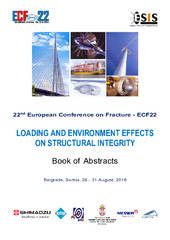Приказ основних података о документу
Numerical simulation of fracture in Ti-6Al-4V alloy for orthopedic applications,
| dc.creator | Cvijović-Alagić, Ivana | |
| dc.creator | Međo, Bojan | |
| dc.creator | Cvijović, Zorica | |
| dc.creator | Gubeljak, Nenad | |
| dc.creator | Rakin, Marko | |
| dc.date.accessioned | 2023-03-22T11:02:47Z | |
| dc.date.available | 2023-03-22T11:02:47Z | |
| dc.date.issued | 2018 | |
| dc.identifier.isbn | 978-86-900686-0-9 | |
| dc.identifier.uri | http://TechnoRep.tmf.bg.ac.rs/handle/123456789/6298 | |
| dc.description.abstract | The fracture behavior of implant Ti-6Al-4V alloy is essential for its service capability in orthopedic surgery. Therefore, it is very important to understand and predict the fracture resistance of this biomedical material. Although several micromechanical models have been developed for modeling the fracture behavior of metallic materials with ductile dimple fracture as predominant fracture mode, they have predominantly been applied to materials such as steels and aluminum alloys. Recently, efforts have been made to apply these micromechanical models to predict crack initiation and growth in two-phase titanium alloys. Due to the complex multiple fracture micromechanisms operative in these alloys, it is necessary to check the applicability of damage models on these materials. In the present study, the mechanical testing and numerical simulation are carried out to characterize the fracture behavior of an extra-low impurity (ELI) Ti-6Al-4V alloy solution treated below β transus temperature followed by water quenching in order to obtain the globular microstructure with 82 vol.% primary α and 18 vol.% β phase. The compact tension (CT) specimen is used for fracture testing. The crack tip opening displacement (CTOD) and strain distribution near the crack tip are measured on its surface by the digital stereometric method. The complete Gurson model (CGM) implemented in a finite element (FE) code ABAQUS is applied to predict the crack resistance (CTOD-R) curves and crack growth initiation (CTODi) values. A relatively good correlation between the experimental and results obtained by numerical simulation demonstrates the applicability of CGM for the prediction of fracture behavior in Ti-6Al-4V ELI alloy with given microstructure. The better agreement, in comparison with plane strain conditions, is achieved through a 3D ½ symmetrical FE model with appropriate FE size. The microstructural effects on the fracture mechanics parameter and fracture modeling are discussed. | sr |
| dc.language.iso | en | sr |
| dc.publisher | The Society for Structural Integrity and Life | sr |
| dc.relation | info:eu-repo/grantAgreement/MESTD/Basic Research (BR or ON)/174004/RS// | sr |
| dc.rights | openAccess | sr |
| dc.rights.uri | https://creativecommons.org/licenses/by/4.0/ | |
| dc.source | 22nd European Conference on Fracture - ECF22 | sr |
| dc.subject | Titanium alloy | sr |
| dc.subject | fracture mechanics | sr |
| dc.subject | finite elements | sr |
| dc.subject | modeling | sr |
| dc.subject | complete Gurson model | sr |
| dc.title | Numerical simulation of fracture in Ti-6Al-4V alloy for orthopedic applications, | sr |
| dc.type | conferenceObject | sr |
| dc.rights.license | BY | sr |
| dc.citation.spage | 392 | |
| dc.identifier.fulltext | http://TechnoRep.tmf.bg.ac.rs/bitstream/id/16815/bitstream_16815.pdf | |
| dc.identifier.rcub | https://hdl.handle.net/21.15107/rcub_technorep_6298 | |
| dc.type.version | publishedVersion | sr |

